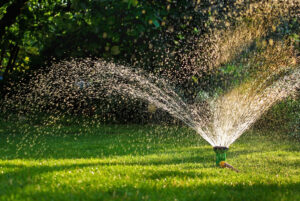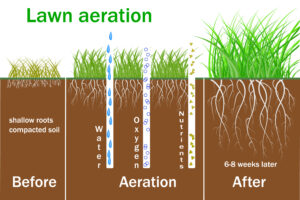Weather Report
Fall Season 2025
Pumpkin Spice & Everything Nice. The Ultimate Fall Guide for Your Lawn.
The leaves are changing, the air is crisp, there’s pumpkins on the front step. That can only mean one thing, it’s finally your lawn’s favorite season.
What are we seeing in the Connecticut, New York and New Jersey area? (Updated weekly)
It’s mid-October — the Ides of October — and the weather across the Tri-State area has been picture-perfect for lawns.
Recent temperatures in the 60s and 70s create ideal conditions for both seed and root growth. Grass thrives in this mix of mild days and cooler nights, and even a little evening chill won’t slow it down.
We’ve also seen some welcome rainfall, which is helping new seed germinate and strengthening existing turf. For homeowners still addressing a few bare spots from summer, this is the perfect window to encourage healthy growth.
Just remember — consistent moisture is key. While rain has been steady, it’s important to water on the dry in-between days to keep the seed damp and growing strong.
With more mild weather ahead, expect your lawn to continue thriving over the next few weeks.
Two tips for your Fall Lawn:
- Clean up your leaves
- Do not mow your lawn too short
What happens to lawns during the fall?
In the fall, several changes occur in your lawn. Here are some key points on what happens to your lawn during this season:
- Foliage Transformation: The leaves on trees surrounding your lawn begin to change color and eventually fall, covering the grass with a colorful carpet of leaves.
- Cooler Temperatures: As temperatures drop, grass growth slows down. This can lead to a lusher and more vibrant appearance as the grass conserves energy.
- Decreased Sunlight: With shorter days, there is less sunlight available for photosynthesis, which can impact the grass’s growth and color.
- Increased Moisture: Fall often brings more rainfall, which can promote fungal growth and moss in the lawn if drainage is poor.
- Preparing for Winter: Grass starts storing energy and nutrients in the roots in preparation for the winter months when growth is minimal.
- Weed Growth Slows: Many weeds also start to slow down or die off in the fall, making it an ideal time for weed control efforts.
- Aeration and Overseeding: Many homeowners choose to aerate their lawns in the fall to relieve soil compaction and overseed to promote thicker, healthier grass.
- Leaf Cleanup: Regular leaf removal is necessary to prevent smothering the grass and promoting a healthy lawn.
- Pest Activity: Some pests and insects become more active in the fall, which can require attention if they threaten your lawn.
- Preparation for Winterization: Before winter arrives, lawns may need fertilization and other preparations to ensure they withstand the cold months.
Overall, your lawn goes through a transition in the fall as it prepares for the winter dormancy and responds to changing environmental conditions. Let’s break some of these points apart.
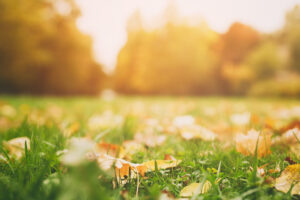
Aeration and Seeding in the Fall
In the summer, your lawn is stressed. It may have suffered from the dry summer heat, disease activity and excessive activity on the grass in general. So what does this mean? It needs to breathe! Aerating in the fall reduces soil compaction allowing water, oxygen and nutrients to flow through the surface. This allows the roots of the plant to grow deeper and stronger for a better looking and healthier lawn.
So what is aeration? Aeration involves perforating the soil with small holes to allow air, water, and nutrients to penetrate deeper into the root zone. This process offers several benefits:
1. Reduced Soil Compaction: Over time, soil can become compacted due to foot traffic, heavy equipment, and natural settling. Compacted soil restricts the movement of air, water, and nutrients, making it challenging for grass roots to thrive. Fall aeration relieves soil compaction, improving the flow of essential resources to the root zone.
2. Enhanced Root Growth: Aeration creates channels in the soil, allowing grass roots to penetrate deeper. Deeper roots are more resilient and better able to access moisture and nutrients, resulting in a healthier and more drought-resistant lawn.
3. Improved Air Exchange: By creating holes in the soil, aeration promotes better air exchange between the atmosphere and the root zone. This encourages microbial activity, which is vital for breaking down organic matter and improving soil structure.
4. Increased Water Infiltration: Aeration improves the soil’s ability to absorb water, reducing runoff and helping to prevent puddles and waterlogged areas during heavy rain or irrigation.
5. Nutrient Uptake: Deeper roots and improved soil structure allow grass to access nutrients more effectively. This can lead to greener, healthier grass.
6. Thatch Reduction: Thatch is a layer of dead grass and organic matter that can accumulate on the soil’s surface. Aeration helps to break up thatch and promote its decomposition, preventing it from becoming a barrier to root growth.
7. Preparation for Seeding: Aeration provides an excellent foundation for seeding. The holes created during aeration offer a perfect environment for new grass seed to make contact with the soil and establish itself.
8. Lawn Health and Longevity: Regular aeration in the fall contributes to the overall health and longevity of your lawn. A healthier lawn is better equipped to withstand stresses, including drought, heat, and pests.
9. Reduced Disease and Pest Issues: A well-aerated lawn is less prone to diseases and pests because it’s healthier and less conducive to these problems.
10. Enhanced Lawn Appearance: Aeration can lead to a more vibrant, lush, and visually appealing lawn.
When performing aeration in the fall, be sure to use the appropriate equipment and follow best practices for your specific grass type and region. Fall is an ideal time for aeration because the soil is still warm, and the grass can recover and establish roots before the onset of winter dormancy. Overall, fall aeration is an essential part of maintaining a thriving and resilient lawn.
Now, seeding your lawn in the fall is important for several reasons:
1. Optimal Growing Conditions: Fall offers a combination of warm soil and cooler air temperatures, creating ideal conditions for grass seed germination. This allows the seeds to establish strong root systems before winter dormancy.
2. Less Competition: Weed growth tends to slow down in the fall, which means there is less competition for resources like sunlight, water, and nutrients, allowing the newly seeded grass to thrive.
3. Less Stress on New Seedlings: Summer heat can be harsh on newly germinated grass seedlings. Fall provides a gentler environment with milder temperatures and more consistent moisture levels.
4. Recovery from Summer Stress: Lawns often suffer stress from heat, drought, and foot traffic during the summer. Overseeding in the fall helps rejuvenate the lawn and repair any damage sustained during the warmer months.
5. Thicker, Fuller Lawn: Overseeding in the fall can increase the density of your lawn. This leads to a thicker, more lush appearance, improving the overall aesthetics of your property.
6. Diverse Grass Varieties: Fall seeding allows you to introduce different grass varieties into your lawn, enhancing its resilience and adaptability to changing conditions, such as disease resistance or drought tolerance.
7. Erosion Control: A thicker, healthier lawn helps prevent soil erosion, especially in areas with slopes or heavy rainfall.
8. Longer Growing Season: By seeding in the fall, your grass seedlings have a head start for the next growing season, allowing them to establish deep root systems that will help the lawn better withstand the following summer’s challenges.
9. Reduced Weed Invasion: A well-established lawn is less susceptible to weed invasion, as there are fewer open spaces for weeds to take hold.
10. Improved Overall Lawn Health: By introducing new grass seed and promoting the growth of existing grass, you can enhance the overall health and vitality of your lawn.
It’s important to choose the right type of grass seed for your region and lawn conditions and follow proper seeding and maintenance practices to ensure the best results. here at Teed & Brown, we have a unique, high quality blend that we use to ensure that green carpet look. Seeding your lawn in the fall is a proactive measure to create a resilient, beautiful, and healthy lawn for the coming seasons.
Learn a little more about the growth of seed with our CEO, Christopher Brown: https://youtu.be/i5tdcnVhAp0?si=jQLu7ZVjQQKPwgBU
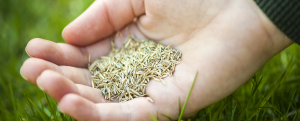
Why Do We Sometimes Use a Drag Mat?
Using a drag mat during aeration serves to help distribute the soil cores and thatch that are pulled to the surface more evenly across the lawn. After core aeration, the extracted soil cores and any loose thatch are left on the lawn. These plugs and debris can create an uneven and unsightly appearance if left concentrated in certain areas. By using a drag mat, also known as a drag mat or a drag harrow, you can achieve several benefits:
1. Even Distribution: The drag mat helps break up the soil cores and thatch and distribute them evenly across the lawn. This prevents the buildup of soil cores in one area, creating a more uniform surface.
2. Promotes Decomposition: Spreading out the soil cores and thatch encourages quicker decomposition. This is important because as these materials break down, they contribute nutrients back to the soil, helping to enrich the turfgrass.
3. Minimizes Disruption: Using a drag mat minimizes the visible disruption caused by the core aeration process. Instead of having scattered plugs and debris, the drag mat helps create a smoother appearance.
4. Enhances Aesthetic Value: A properly used drag mat can improve the overall appearance of the lawn after aeration. It creates a neater look that blends the soil cores and thatch with the surrounding turf.
5. Improves Seed-to-Soil Contact: If overseeding is planned after aeration, using a drag mat can help create better seed-to-soil contact. This increases the likelihood of successful germination and establishment of new grass seed.
6. Encourages Topdressing Penetration: If you plan to apply a topdressing of soil, compost, or other materials after aeration, using a drag mat can help work these materials into the aeration holes and distribute them more evenly.
Overall, using a drag mat in conjunction with core aeration can help maximize the benefits of the aeration process and contribute to a healthier, more attractive lawn.
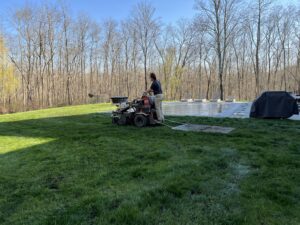
LEAVES
Leaves on grass in the fall can have both positive and negative effects, depending on how they are managed:
Positive Aspects:
- Mulch and Nutrient Source: Leaves that are finely chopped or mulched into smaller pieces can provide a natural source of organic matter and nutrients for your lawn. As they decompose, they release essential nutrients back into the soil, benefiting your grass.
- Winter Insulation: A light layer of leaves can act as natural insulation, helping to protect the grass from extreme temperature fluctuations and frost during the winter months.
Negative Aspects:
- Sunlight Blockage: A thick layer of leaves can block sunlight from reaching the grass, inhibiting photosynthesis and potentially weakening the grass. This can lead to thinning or dead patches in your lawn.
- Moisture Retention: Piles of leaves can trap moisture on the lawn’s surface, promoting fungal diseases like snow mold. Excessive moisture can also cause rot in grass and create an environment for pests.
- Insect Habitats: Leaves can provide shelter and breeding grounds for insects and pests that might damage your lawn, like grubs or rodents.
- Smothering: Heavy, wet leaves can smother and compress the grass, leading to soil compaction and potential root damage.
To manage leaves on your grass effectively in the fall, consider these steps:
- Mulching: Use a mulching mower to finely chop the leaves into small pieces. The mulched leaves can be left on the lawn to decompose and provide nutrients.
- Raking or Blowing: Regularly rake or blow leaves off your lawn to prevent a thick layer from forming.
- Composting: Collect leaves and add them to a compost pile. Once decomposed, you can use the resulting compost to enrich your garden or flower beds.
- Leaf Vacuum: Use a leaf vacuum to collect and bag leaves efficiently.
- Lawn Debris Removal: If your local waste management services offer lawn debris collection, take advantage of it.
Overall, it’s important to manage leaves on your grass to maintain a healthy and thriving lawn during the fall and beyond. But if you do receive our services please do make sure to have your leaves removed prior to your scheduled service!
Learn more about mulching your leaves with CEO, Cristopher Brown here: https://youtu.be/id0u1Iok7_I?si=jUhso-PKXTnkyLCN
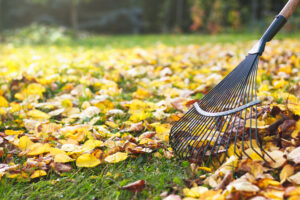
Mowing
While the temperatures are still ideal, your grass will continue to grow. So make sure you are are mowing correctly. Here are some tips to follow:
- SHARPEN THE MOWER BLADES!
We can’t stress enough how important this is. Sharp blades are critical for plant health. - IT’S OKAY TO LEAVE THE CLIPPINGS!
The grass clippings will provide and return vital nutrients to the soil. There’s no benefit to taking those away. - LONGER IS BETTER!
Mowing your lawn between 3 and 3 1/2 inches long has proven to be ideal for healthy grass in a home lawn.
Understand the importance of these steps a little further with Christopher Brown by clicking on the link: https://youtu.be/EqR837mg318
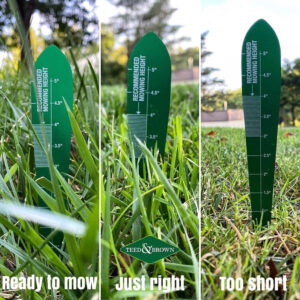
Watering After an Aeration Service
Watering your lawn properly after core aeration is essential to ensure the success of the aeration process and any subsequent overseeding or lawn repair efforts. Here’s a guide on how to water your lawn after aeration:
1. Initial Watering: After the core aeration process is complete, water the lawn thoroughly. This initial watering helps settle the soil and newly created aeration holes, ensuring good seed-to-soil contact if you’re planning to overseed.
2. Consistent Moisture: Keep the soil consistently moist in the days following aeration and overseeding. This means watering lightly but frequently to prevent the soil from drying out. The goal is to provide an environment that promotes seed germination and establishment.
3. Avoid Overwatering: While it’s important to keep the soil moist, be cautious not to overwater. Overwatering can lead to waterlogged conditions, disease issues, and poor grass growth. Use a light touch and monitor the soil’s moisture level to avoid excessive watering.
4. Time of Day: Water your lawn in the early morning if possible. Morning watering allows the grass to dry out during the day, reducing the risk of fungal diseases that can thrive in moist conditions. Avoid watering in the evening, as extended moisture overnight can encourage disease development.
5. Adjust Sprinklers: Make sure your sprinklers are set to deliver even coverage. Test the coverage pattern and adjust the sprinkler heads as needed to ensure that all areas receive adequate moisture.
6. Watering Depth: Water deeply but infrequently. This encourages the development of deep root systems. Aim for about 6 to 8 inches of moisture penetration into the soil. You can check this by inserting a screwdriver or a soil probe into the ground after watering to see how far the moisture has reached.
7. Evaporation Considerations: If the weather is particularly hot, windy, or dry, you may need to water more frequently to counteract evaporation. Adjust your watering schedule based on the specific weather conditions.
8. Gradual Reduction: As the new grass becomes established, you can gradually reduce the frequency of watering. This encourages the grass roots to grow deeper in search of moisture, leading to a healthier and more drought-resistant lawn.
9. Monitor Soil Conditions: Regularly check the soil moisture level by digging a small hole in the ground and feeling the soil. Adjust your watering schedule based on the moisture level to ensure the soil remains consistently moist but not waterlogged.
Remember that proper watering practices are essential for the health and success of your lawn, whether or not you’ve recently aerated or overseeded. Consistent and mindful watering helps your lawn thrive and ensures the best possible results from your lawn care efforts.
